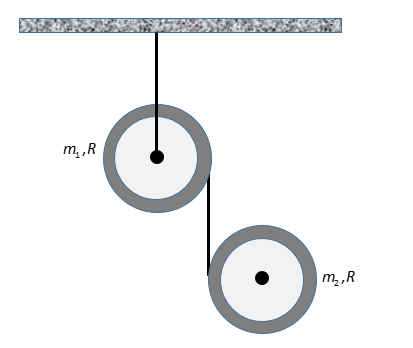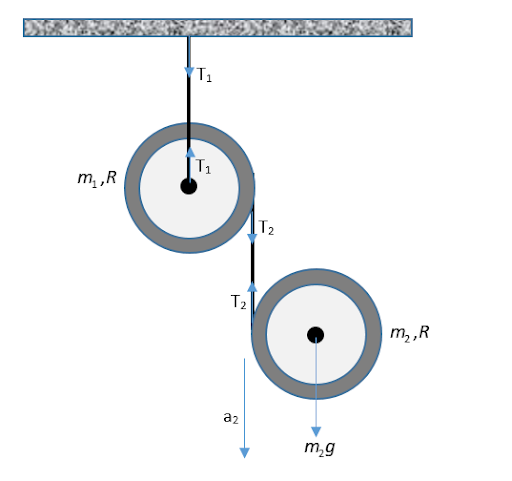
Linear acceleration of mass \[{m_2}\]is \[{a_2}\], then angular acceleration of \[{\alpha _1}\]is (given that there is no slipping).

A. \[\dfrac{{{a_2}}}{R}\]
B. \[\dfrac{{\left( {{a_2} + g} \right)}}{R}\]
C. \[\dfrac{{2\left( {{a_2} + g} \right)}}{R}\]
D. None of these
Answer
217.5k+ views
Hint: For no slipping condition or pure rotation condition the surface in contact is at instantaneous rest, i.e. the net force acting at that point is zero and hence there is no relative acceleration of the point.
Complete step by step solution:

Image: Two rings joined by common string
Let the tension in the string connected with mass \[{m_1}\] is \[{T_1}\] and the tension in the string connecting both the masses is \[{T_2}\]. \[{\alpha _1}\] is the acceleration of the mass \[{m_1}\], \[{a_2}\] is the linear acceleration of the mass \[{m_2}\] and \[{\alpha _2}\] is the angular acceleration of the mass \[{m_2}\].
For mass \[{m_2}\] writing the Newton’s 2nd law of motion,
\[\begin{array}{c}{F_{net}} = ma\\ \Rightarrow {m_2}g - {T_2} = {m_2}{a_2} \ldots \ldots \left( i \right)\end{array}\]
The moment of inertia of the circular ring about its centre of mass is given as,
\[I = M{R^2}\]
Here, \[M\] is the mass and \[R\] is the radius of the ring.
So,
\[\begin{array}{c}{I_1} = {m_1}{R^2}\\{I_2} = {m_2}{R^2}\end{array}\]
Net torque acting about the centre of mass \[{m_2}\] is \[{T_2}R\] and the direction is clockwise. For no slipping condition,
\[{a_2} = {\alpha _2}R\]
So, the angular acceleration will be,
\[{\alpha _2} = \dfrac{{{a_2}}}{R}\]
For mass\[{m_1}\],
Using no slipping condition,
\[{c}{\alpha _1} = {\alpha _2}\]
\[\therefore {\alpha _1}= \dfrac{{{a_2}}}{R}\]
Therefore, the correct option is A.
Note: We need to assume that the string connecting both the rings are massless and inextensible. If the string is not massless and inextensible then the tension at the point of contact will be different for both the rings. If the motion is not purely rolling/slipping then we can’t use the used relation between the angular acceleration and the linear acceleration for both the rings. The linear acceleration of mass \[{m_1}\] should be zero as its centre is attached to an inextensible and immovable string.
Complete step by step solution:

Image: Two rings joined by common string
Let the tension in the string connected with mass \[{m_1}\] is \[{T_1}\] and the tension in the string connecting both the masses is \[{T_2}\]. \[{\alpha _1}\] is the acceleration of the mass \[{m_1}\], \[{a_2}\] is the linear acceleration of the mass \[{m_2}\] and \[{\alpha _2}\] is the angular acceleration of the mass \[{m_2}\].
For mass \[{m_2}\] writing the Newton’s 2nd law of motion,
\[\begin{array}{c}{F_{net}} = ma\\ \Rightarrow {m_2}g - {T_2} = {m_2}{a_2} \ldots \ldots \left( i \right)\end{array}\]
The moment of inertia of the circular ring about its centre of mass is given as,
\[I = M{R^2}\]
Here, \[M\] is the mass and \[R\] is the radius of the ring.
So,
\[\begin{array}{c}{I_1} = {m_1}{R^2}\\{I_2} = {m_2}{R^2}\end{array}\]
Net torque acting about the centre of mass \[{m_2}\] is \[{T_2}R\] and the direction is clockwise. For no slipping condition,
\[{a_2} = {\alpha _2}R\]
So, the angular acceleration will be,
\[{\alpha _2} = \dfrac{{{a_2}}}{R}\]
For mass\[{m_1}\],
Using no slipping condition,
\[{c}{\alpha _1} = {\alpha _2}\]
\[\therefore {\alpha _1}= \dfrac{{{a_2}}}{R}\]
Therefore, the correct option is A.
Note: We need to assume that the string connecting both the rings are massless and inextensible. If the string is not massless and inextensible then the tension at the point of contact will be different for both the rings. If the motion is not purely rolling/slipping then we can’t use the used relation between the angular acceleration and the linear acceleration for both the rings. The linear acceleration of mass \[{m_1}\] should be zero as its centre is attached to an inextensible and immovable string.
Recently Updated Pages
Elastic Collision in Two Dimensions Explained Simply

Elastic Collisions in One Dimension Explained

Electric Field Due to a Uniformly Charged Ring Explained

Electric Field of Infinite Line Charge and Cylinders Explained

Electric Flux and Area Vector Explained Simply

Electric Field of a Charged Spherical Shell Explained

Trending doubts
JEE Main 2026: Application Form Open, Exam Dates, Syllabus, Eligibility & Question Papers

Derivation of Equation of Trajectory Explained for Students

Hybridisation in Chemistry – Concept, Types & Applications

Understanding the Angle of Deviation in a Prism

Understanding Collisions: Types and Examples for Students

How to Convert a Galvanometer into an Ammeter or Voltmeter

Other Pages
JEE Advanced Marks vs Ranks 2025: Understanding Category-wise Qualifying Marks and Previous Year Cut-offs

Units And Measurements Class 11 Physics Chapter 1 CBSE Notes - 2025-26

NCERT Solutions For Class 11 Physics Chapter 8 Mechanical Properties Of Solids

Motion in a Straight Line Class 11 Physics Chapter 2 CBSE Notes - 2025-26

NCERT Solutions for Class 11 Physics Chapter 7 Gravitation 2025-26

Understanding Atomic Structure for Beginners




